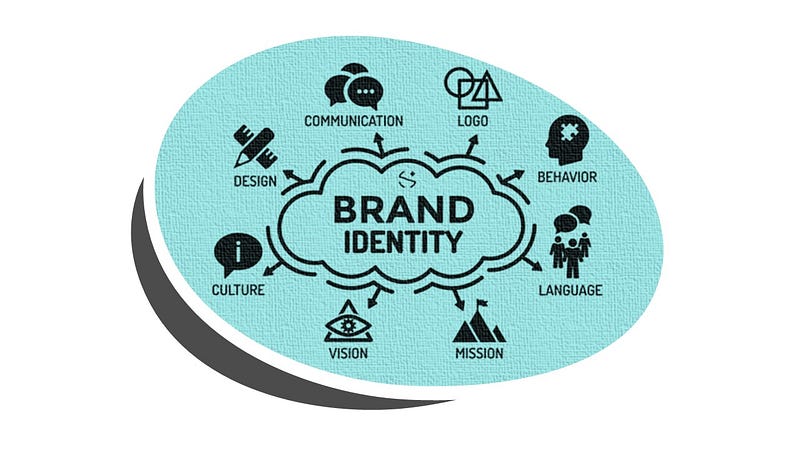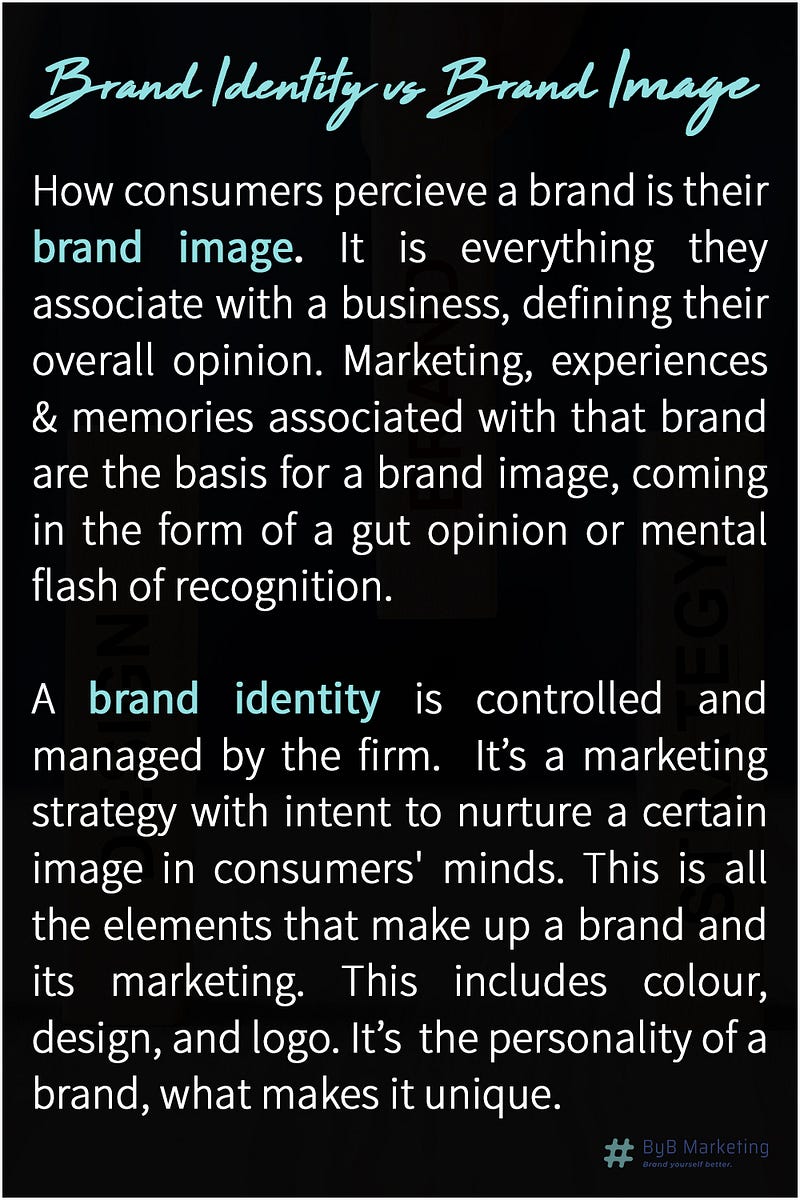
A common mistake from beginner marketers is confusing their businesses brand image with their brand identity. I get it. They sound similar and are connected concepts.
But they are not… Our brand identity is what we think our brand is and the brand image is what customers think our brand is. However, our brand identity does influence how our brand image is perceived.
This article explores what a brand identity, its importance and strategies a business can use to create their own brand identity.
How your Brand Identity Influences your Brand Image
A brand image is distinct from the brand identity.
A brand’s identity is its intent to cultivate a certain image in consumers’ minds. How a brand is perceived is the brand image. Therefore, brands do not control the brand image, they can merely try and influence this perception.
Everything a potential customer associates or identifies with a business or a product from previous experiences or through advertising creates a perception of that brand. Brand image is the result of a firm’s branding efforts — successful or unsuccessful.
Marketing, experiences and memories associated with that brand are the basis for a brand image, and it comes in the form of a gut opinion or mental flash of recognition.
The brand identity signifies what a firm wants its brand to stand for. They control this with all the elements that make up a brand and its marketing. All the visible elements of a brand, such as its colours, design features, and logo. It is a marketing strategy to nurture a certain image in consumers’ minds that identify and distinguish the brand.
“Companies that present a cohesive, distinctive, and relevant brand identity can create a preference in the marketplace, add value to their products and services, and may command a price premium.” (Schmitt & Simonson, 1997).

What is a Brand?
Many people associate a brand with a logo or a name, but a logo is not a brand. The terms are often used interchangeably, and although the logo is often the visual symbol of a business, it is not a brand’s entirety.
‘Branding’ was originally the identifying marks burnt into the skin of livestock, slaves and criminals. Symbols such as national, religious, or guild date back hundreds of years — this is another origin of branding.
Modern branding dates to the industrial revolution when factories started producing goods and brands were used by manufacturers to differentiate themselves from the other manufacturers.
Simple visual branding evolved to include advertising, mascots, jingles, and other marketing techniques.
A strong brand “increases customers’ trust of invisible products, while helping them to better understand and visualise what they are buying.” (Berry, 2000)
The brand defines everything about our business.
It is the promise to consumers about our products or services. Everything that contributes to customers’ opinions and feelings about your company. It is our reputation, how people recognise us, and how we are distinguished from competing offerings.
Everyday interactions your brand has with consumers, from the website to salespeople, to customer support to advertising. It is all the brand.
CEO of Amazon Jeff Bezos once famously said that your brand is what other people say about you when you are not in the room.
The Objectives of a Brand Identity
A brand’s identity supports its strategy by communicating the brand visually to differentiate it from competitor products/services.
This helps shape the long-term impression of a brand. How a brand communicates its position in the market, what their values are, how the products are unique, and how you want customers to feel. The brand becomes more distinguished in consumers’ minds and encourages them to engage.
Components of the brand such as colours and imagery represent who the brand is, complemented with a certain tone of voice. This becomes a template for the look and feel of the company’s marketing.
“A brand’s personality provides a richer source of competitive advantage than any functional feature can.” (Sherrington, 2003)
Brand Personality
Every brand should reflect certain personality traits to humanise it, so customers find them easy to relate to. Brand messaging in marketing communicates in a certain voice to establish a unique personality. Examples of personality traits are:
- innovative,
- socially conscious,
- trustworthy,
- friendly,
- nostalgic,
- luxury,
- cool,
- socially conscious.
An example might be ‘tough’ for an off-road vehicle or ‘fit’ for sportswear.
This personality should be reflected in the brand positioning — which is how a brand is perceived against its competitors. This includes the brand promise — its unique selling proposition, and brand values which guides a firm’s decision-making.
A unique set of brand associations enable a brand to develop a rich and clear brand identity. While some customers may attach greater importance to functional benefits, emotional value helps the brand stand above others. (Ghodeswar, 2008)
Brand Associations
Brands create personality characteristics that they want customers to associate with their brand. However, the associations a brand creates with their brand identity is not always perceived the same way by customers.
Customer assessments and opinions of a brand become the anchor for their associations of what a brand represents. New associations are continuously made with brands, simultaneously with each interaction. These assessments are evaluated against a consumer’s values and lifestyle.
The content you create and share on your social media influences perceptions of your brand. It defines your brand. If you share boring content and talk about yourself all the time, that is the brand people will associate with you.
Associations can be how your brand looks, feels, and speaks to people. Even how it tastes, feels, sounds, and smells.
These assessments evaluated against a consumer’s personal and cultural values. When people have an unfavourable experience, they correlate that negative experience with everything associated with that brand.
“A brand tends to have a strong and attractive identity when the identity is more distinctive and more prestigious.” (He, Li, & Harris, 2012)
Why is a Strong Brand Identity so Important?
A well-researched and distinct brand identity should be the foundation of any successful business.
A brand identity aims to influence customer perceptions of the brand and its products or services. A strong brand identity increases the target market’s awareness of that brand. Brand awareness is a customer’s ability to identify a brand in a saturated market. If brand identification is high and customers trust the brand, companies gain a competitive advantage of competitors and enhance their brand value.
Having a strong brand identity means consumers are more likely to develop an emotional connection with the brand, forming a stronger customer-brand relationship and encouraging loyalty.
“Brand identity management should be the starting point of integrated marketing communications for the purpose of building brand loyalty.” (He, Li, & Harris, 2012).
Credibility and Trust
A strong brand establishes trust and credibility with customers and prospective customers. Brand identity makes a brand more memorable and increases its authority in the marketplace. Because of this, having a strong identity can often make new product rollouts more successful because of the trust customers have in the brand.
Strong brand identities will attract people who resonate with what a brand has to offer and what it stands for. A brand's community can give them a sense of belonging.
This satisfies the symbolic needs of customers more than their functional needs, helping them fulfil their need for uniqueness.
“Strong brands enjoy customer loyalty, the potential to charge premium prices, and considerable brand power to support new product and service launches.” (Ghodeswar, 2008)
A firm can create a positive brand identity that fails to translate into a positive brand image. If a brand identity does not translate with consumers’ image of the brand, it will negatively affect the sales results. Brands must have a willingness to invest in themselves to live up to their promise to customers.
Apple’s brand identity and brand image are closely aligned. Apple is very deliberate in its strategy of creating hype for the release of their new products, in a way to create hype. They position themselves as a premium offering due to their investments into modern technologies and bringing them to the market first.
“A strong brand identity that is well understood and experienced by the customers helps in developing trust which, in turn, results in differentiating the brand from competition.” (Ghodeswar, 2008)
How to Create a Brand Identity
A brand identity should be constructed to represent our business.
Creating a brand is more than just picking a few colours and creating a logo. It needs to be approached strategically. We need to be able to stand out amongst the competition and capture the attention of our target market. Through creating differentiation, our brand becomes more visible, relevant, unique, distinct and memorable.
Our brand should be cohesive and translatable across communication platforms and be flexible enough to evolve with the brand and easy for designers to apply.
“Building brand associations requires a company to understand its brand as well as competitors’ brands through customer research.” (Ghodeswar, 2008)
Analyse Your Firm, the Market and the Competition
Creating a brand image requires an analysis of your firm and the marketplace. Firstly, what are the company’s vision and goals? What makes it unique? When a firm understands what they stand for and what it is they want to communicate, they can design the communication of their brand identity around that.
Through market research, firms can understand how the brand is perceived.
Talk to customers. What do they think the brand stands for? Our brand identity is also informed by what your brand’s customers want to engage with, so our identity must resonate with them. Therefore, it is important to know our buyer personas.
Talk to customers through surveys, focus groups, and one-on-one interviews.
It is also important to understand their competitive landscape or risk blending in. Find out what (if any) is the difference between our brand and the competition.
“Brand identity is based on a thorough understanding of the firm’s customers, competitors, and business environment.” (Ghodeswar, 2008)
Consistency
Consistency in marketing communications leads to consistent brand identity.
Your branding’s appearance should always be cohesive and consistent across the business. Each piece complements the brand identity.
Components such as:
- Logo
- Design and Colours
- Typography (fonts)
- Photography, illustration and data visualization such as infographics
- Video and motion
- Web design
- Packaging
- Tone and language
- Other marketing such as social media
- Employee communication and customer service
Every element needs to support the overall message and business goals.
Visuals
The brand personality, goals, and values should be translated into visual concepts to communicate. How much visual impact a brand makes can increase the likelihood of being remembered.
The logo is the most recognisable part of a brand — it is the face of your business. Many businesses have logos that do not have a defining feature. It must become synonymous with your brand; it must be unique.
Online, your marketing content is your brand. Every piece of content defines your brand. Great content, great brand. Boring content, boring brand.
Use language and a tone to match the personality of your brand. For example, if your brand identity is of a premium offering, use professional language.
Colour is used as a tool to differentiate your brand from the alternatives, but it can also elicit strong emotions. Brands should create a unique colour palette of 1 main colour, 2 primary colours and 2 accent colours. It provides you with variety while remaining true to the brand identity.
Your brand should use the same fonts as often as possible. Limit the number of font families to 2–3. There is usually one primary font and then a couple of secondary brand typefaces. This should be consistent across the logo, website, advertising and any document such as letters, emails.
Thanks for reading this article on brand identity.
In summary, your brand identity is how you want to be recognised and remembered.
Marketing is used to create a brand identity, which then influences how the brand is perceived by customers - your brand image.
Creating a distinct brand identity will help your business stand out amongst the competition.
This was originally posted on the BYB Marketing blog: https://brandyourselfbetter.com/blog/post/170507/how-to-create-a-brand-identity-to-attract-more-customers


No comments:
Post a Comment